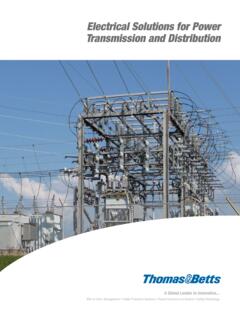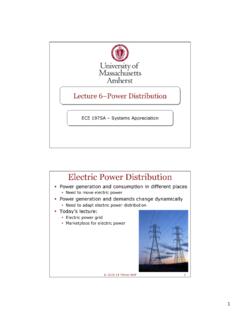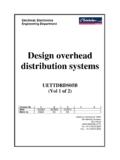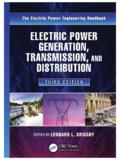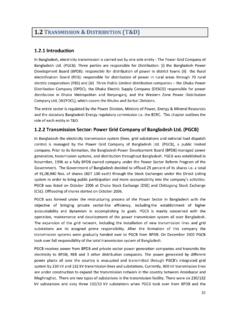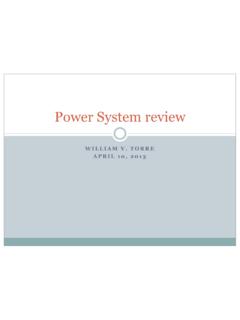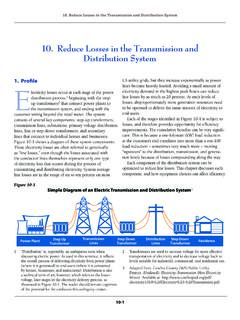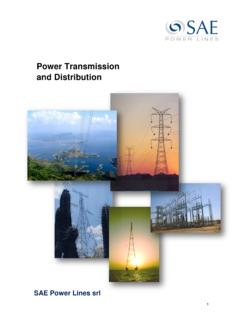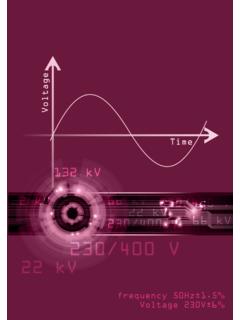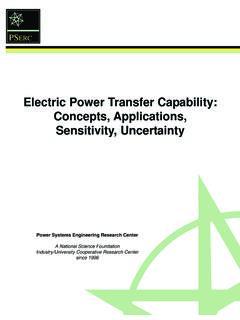Transcription of An Introduction to Electric Power Transmission …
1 An Introduction to Electric PowerTransmission1 Western Governors Association2An Introduction to Electric PowerTransmission Table of Content (TOC) Glossary About Transmission Lines Electricity Generation and Delivery Transmission Line Ownership and Funding Anatomy of a Transmission Line Building/Maintaining Transmission Lines Planning the System Permitting Potential Environmental Impacts Aesthetic Visual Resources Cultural/Archeological Resources Threatened and Endangered Species Local Geologic Features Invasive Species Water Resources Wetlands Wooded and Forested AreasGlossary1 Western Governors AssociationBack to TOC4 Basic Definition/Terminology Alternating Current (AC)
2 Electric current in which thedirection of the current's flow is reversed or alternated at60Hz in the Audible Noise (AN) A measure in units of decibels on alogarithmic scale. Because human hearing is not equallysensitive to all frequencies of sound, certain frequencies aregiven more weight. Noise levels capable of being heard byhumans are measured in A-weighted decibels (dBA). Conductors ( Power Lines) Metal cables used for carryingelectric current. Corona Electrical breakdown of the air near high voltageconductors into charged to TOC5 Current The flow of electricity or the movement ofelectrons through a conductor typically measured in watts.
3 Direct Current (DC) Electric current flows continuously inthe same direction as contrasted with alternating current. distribution Line A line that carries electricity at lowervoltages of 12kV to 44kV and is used to distribute powerdrawn from high-voltage Transmission systems to end-usecustomers. Electric & Magnetic Fields (EMF) Invisible areas of energy,often referred to as radiation, that are associated with theuse of Electric Power . EMFs fall into one of two radioactivecategories non-ionizing (low-level of radiation) or ionizing(high-level of radiation).Basic Definition/TerminologyBack to TOC6 Basic Definition/Terminology Electric Load Electricity consumers, such as residences,businesses, and government centers that use electricity.
4 Electric Power Transmission The process by which largeamounts of electricity produced are transported over longdistances for eventual use by consumers. Energy The amount of work that can be done by electricity,typically measured in kilowatt-hours (kWh) or megawatt-hours (MWh). Foundation System that transfers to the ground the variousdead and live loads of the Transmission structure andconductors. Generation The production of Electric energy. Fossil fuels,wind turbines, solar panels, and other technologies are usedto generate to TOC7 Basic Definition/Terminology Insulators Used to contain, separate, or support electricalconductors. Interconnection Points on a grid or network where two ormore Transmission lines are connected at a substation orswitching station, or where one stage of the energy supplychain meets the next.
5 Load Center A particular geographical area where energy isused. Most commonly refers to an area within a utility sservice territory where energy demand is highest ( , cities,major industrial areas, etc.). National Electrical Safety Code (NESC) The NESC is the of the safe installation, operation, and maintenanceof Electric Power to TOC8 Basic Definition/Terminology Power Rate at which electricity does work. Measured in wattsor kilowatts (kW) or megawatts (MW). Rights-of-Way (ROW) A legal land right, easement, set asidefor the Transmission line structure and conductors needed forclearances and maintenance activities. Shield and Ground Wire Wires used primarily for protectionfrom lightning strikes and corresponding surges.
6 Substation A part of an electrical Transmission system thattransforms voltage from high to low, or the reverse. Switching Station A part of an electrical Transmission systemthat ties two or more Electric circuits together throughswitches, to permit a circuit to be disconnected, or to changethe Electric connection between to TOC9 Basic Definition/Terminology Transmission Line A line that carries electricity atvoltages of 69kV or greater and is used to transmitelectric Power over relatively long distances, usuallyfrom a central generating station to main substations. Transmission Structures Used to keep high-voltageconductors ( Power lines) separated from theirsurroundings and from each other.
7 Voltage Electric pressure measured in volts. Powersystems are typically measured in 1,000s volts or kV. Watt Unit of electrical Power . 1MW is one to TOC10 About transmissions LinesElectricity Generation and DeliveryBack to TOC11 Electricity Generation and DeliveryElectric Operating SystemsThe National Electric Grid The Electric grid is a complex interconnected system of electrictransmission lines linking generators to : FEMABack to TOC12 Electricity Generation and DeliveryElectric Operating SystemsThe Electric Power SystemThe diagram depicts the basicelements of an Electric powersystem: Generation Where energy iscreated Transmission and distribution Energy is transported acrosshigh-voltage Transmission tolower-voltage distribution lines Load Power is delivered tohomes and businessesTransformers at generating stationsstep the Electric voltage up forefficient transportDistribution substations step theelectric voltage down to efficientlydeliver Power to customersBack to TOC13 Electricity Generation and DeliveryInterconnections and Reliability The national grid is overseen by theFederal Energy Regulatory Commission(FERC) and the North American ElectricReliability Corporation (NERC).
8 3 Regional Interconnections 8 Regional Entities 8 Independent System Operators (ISO) 4 Regional Transmission Organizations (RTO) Entities responsible for reliability ofthe national grid system: FERC, NERC Regional Entities Utilities Regional Transmission Organizations (RTOs) Independent System Organization (ISOs)Source: : to TOC14 Electricity Generation and DeliveryThe Western GridWestern Interconnect Bulk movement ofelectricity isaccomplished withinthree electrically separatezones: The Western Interconnect The Eastern Interconnect The Texas Interconnect The Western Interconnectis composed of 11 states,two Canadian provinces,and northern to TOC15 Electricity Generation and DeliveryThe Western GridWestern Interconnect Two Federal Power MarketingAgencies (FPMAs) Bonneville Power Administration (BPA) Western Area Power Administration(WAPA) Thirty seven balancing authorities(BAs) Alternating and Direct CurrentResources Four Transmission PlanningAgencies.
9 Columbia Grid Northern Tier West Connect Cal- is illustrative anddoes not show alltransmission to TOC16 Electricity Generation and DeliveryThe Western GridOperational Constraints As one large machine, the WesternInterconnect must be balancedmoment to moment (frequencybased). In other words, energy that isgenerated must be consumedimmediately as there is minimalstorage in the system. Under or over supply leads todisruptions (blackouts) and thoseare reliability to TOC17 Electricity Generation and Delivery For each of the three Transmission grids theNational Electricity Reliability Corporation (NERC)defines reliability. If your lights came on, reliability was met.
10 If a major line is lost and the system remains stable,reliability was met. If a generation source is lost and thesystem remains stable, reliabilitywas met. It is more complicated in reality, butif it is not met, the provider can is meant by reliability?Back to TOC18 About transmissions LinesTransmission Line Ownership and FundingBack to TOC19 Transmission Ownership & FundingTransmission Ownership/Funding Electric Utility privately-held company, governmentagency, publicly owned body, or other entity that meetsthree specific criteria. Owns and/or operates facilities for provision of a servicedirectly related to Electric energy provision Transmission providers fall into the following categories:1.
